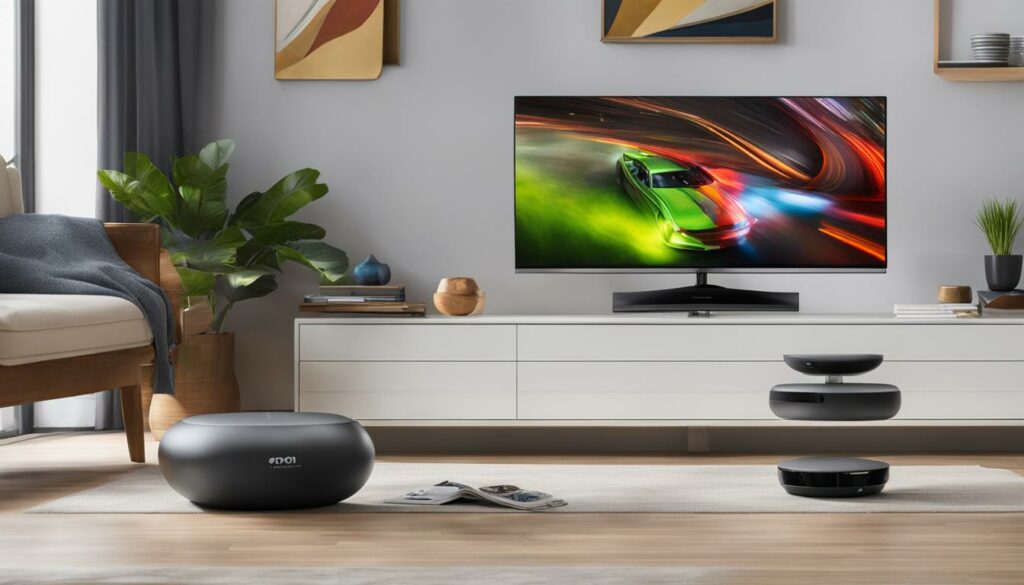When it comes to internet speed, there’s often a debate on what is considered good or bad. One speed that is frequently discussed is 200 Mbps. But is it a good speed for you? Let’s take a closer look.
Before we dive into the pros and cons of a 200 Mbps connection, it’s important to understand what exactly this speed means. Mbps stands for “Megabits per second,” and it measures how many bits can be transferred each second on a home internet connection. This speed encompasses both download and upload speeds.
Now let’s consider the advantages of a 200 Mbps connection. With this speed, you’ll be able to enjoy seamless streaming of HD and even 4K content without buffering. It also provides a stable and reliable connection for online gaming, ensuring minimal lag and a smooth gaming experience. Additionally, for those who work from home, a 200 Mbps connection can handle video conferences, file transfers, and multiple devices connected simultaneously.
However, there are also a few factors to consider before determining if 200 Mbps is the right speed for you. Firstly, your household’s specific internet needs play a significant role. The number of connected devices, streaming habits, and online gaming can all impact the ideal internet speed for your household. It’s important to assess these factors before making a decision.
Another consideration is your location. Internet speeds can vary based on where you live. Rural areas typically have lower speeds and fewer options compared to urban centers, where higher speeds are more readily available. It’s worth noting that broadband connection availability can significantly impact the range of performance you can expect.
So, is 200 Mbps speed good or bad for you? Ultimately, it depends on your specific requirements. If you frequently stream HD and 4K content, play online games, and work from home, a 200 Mbps connection is likely to meet your needs. However, if you have minimal streaming or gaming requirements and fewer connected devices, a lower speed may be sufficient.
In conclusion, while a 200 Mbps speed offers many advantages, it’s essential to assess your household’s needs and consider your location before determining if it’s the right fit for you.
Key Takeaways:
- A 200 Mbps internet speed provides a balance between performance and affordability, catering to various online activities.
- Factors such as the number of connected devices and specific requirements for streaming, gaming, and working from home influence the ideal internet speed.
- Location plays a role in the availability and performance of internet speeds, with rural areas often offering lower speeds compared to urban centers.
- Assessing your household’s internet needs and considering your location are crucial when determining if a 200 Mbps speed is right for you.
- Ultimately, the “goodness” of a 200 Mbps speed varies based on individual requirements and usage.
Understanding Internet Speed Measurements
When it comes to internet speed, you may have come across the term Mbps, which stands for “Megabits per second.” This measurement refers to the number of bits that can be transferred each second on a home internet connection. Understanding Mbps is essential in determining the speed you need for your online activities.
Internet speed comprises two crucial factors: download speed and upload speed. Download speed refers to the rate at which data is delivered from the internet to your device, allowing you to stream videos, download files, and browse websites. Upload speed, on the other hand, measures how fast data is sent from your device to the internet, enabling you to upload files, photos, and videos.
Latency is another factor to consider when evaluating internet speed. It refers to the delay between your device sending a request and receiving a response from a server. Low latency is important for activities such as online gaming and video conferencing, where real-time interaction is crucial.
It’s worth noting that the internet speed you experience may differ from the advertised download speed. This difference can be attributed to various factors, including the quality of your Wi-Fi network and the number of devices connected to it. In general, the speed experienced on Wi-Fi networks is typically 20-50% lower than the advertised download speed.
With a clear understanding of internet speed measurements, you can make informed decisions when choosing an internet plan that suits your needs. In the next section, we will explore the different internet speed requirements based on various online activities.
How Much Internet Speed Do I Need?
When it comes to internet speed requirements, the right amount depends on your online activities. Let’s take a closer look at the recommended speeds for different tasks:
- Basic web browsing and email: 2-5 Mbps is sufficient for everyday browsing, checking emails, and scrolling through social media.
- Streaming HD content: For smooth streaming of high-definition videos, aim for at least 15-25 Mbps. This ensures minimal buffering and a seamless viewing experience.
- Streaming 4K content and online gaming: If you enjoy watching ultra-high-definition 4K content or playing online games, you’ll need a faster connection. These activities may require speeds ranging from 40-100 Mbps or more. With a 200 Mbps connection, you’ll have more than enough speed to support streaming and gaming simultaneously without any lag or interruptions.
- Downloading large files: If you frequently download large files, such as movies or software, a minimum speed of 200 Mbps is recommended. This ensures quick and efficient file transfers, saving you valuable time.
It’s important to remember that internet speed requirements can vary based on the number of devices connected to your network. Additionally, if you have multiple family members or roommates streaming, gaming, or working from home, it’s best to opt for a higher-speed plan to avoid congestion and slowdowns.
Having the right internet speed is crucial for a smooth online experience. Whether you’re casually browsing the web, streaming your favorite shows, participating in online gaming sessions, or working from home, the appropriate speed ensures you can enjoy these activities without any frustrating delays or interruptions.
What is Considered “Good” Internet Speed?
A good internet speed depends on several factors that influence performance, such as the number of connected devices, streaming habits, online gaming, file transfer for work, and tolerance for lag or slow loading times. Each household has different needs, making it essential to consider these factors when determining what constitutes a good internet speed.
For modern households, a connection in the range of 200-300 Mbps is generally considered ideal. This speed provides a balance between performance and affordability, making it suitable for a variety of online activities. With a 200-300 Mbps connection, you can comfortably stream high-definition content, engage in online gaming, conduct video conferences for work, and browse the web without experiencing significant delays or buffering.
It’s worth noting that a significant number of households in the United States have already recognized the importance of a fast internet connection. In fact, 81% of US households subscribe to plans that offer speeds faster than 200 Mbps, highlighting the growing demand for high-speed internet.
In conclusion, determining what constitutes a good internet speed requires considering various factors that influence performance and addressing household needs. While a connection in the 200-300 Mbps range is generally considered ideal for modern households, it’s important to assess specific requirements and usage patterns to ensure the optimal internet speed for your household.
Internet Speed and Location

The performance and availability of internet speeds can vary based on location. The location where you live can have a significant impact on the quality and options of your broadband connection. This is particularly evident when comparing rural areas to urban centers.
In rural areas, internet speeds tend to be lower and options may be limited. It’s not uncommon for rural areas to have speeds around 25 Mbps, which may be sufficient for basic web browsing and email but may not meet the demands of bandwidth-intensive activities such as streaming or online gaming.
On the other hand, urban centers typically offer a wider range of internet speed options, with plans exceeding 100 Mbps being readily available. If you live in an urban area, you can expect faster and more reliable internet connections, allowing you to enjoy bandwidth-hungry activities without experiencing buffering or lag.
Location plays a vital role in the range of performance you can expect from your internet connection. Rural areas often face infrastructure challenges, such as limited access to fiber-optic networks or greater distances between homes and the nearest broadband providers. In contrast, urban centers benefit from a more dense population, making it financially viable for internet service providers to offer high-speed connections.
Comparison of Internet Speeds by Location
| Rural Areas | Urban Centers |
|---|---|
| Average Speed: 25 Mbps | Average Speed: 100+ Mbps |
| Limited Options | Wide Range of Plans |
| Less Reliable Connections | More Reliable Connections |
As you can see, when it comes to internet speed, location matters. Living in a rural area may mean fewer options and slower speeds, while living in an urban center gives you access to faster and more reliable connections. It’s important to keep this in mind when choosing an internet service provider and considering your broadband needs.
Having a clear understanding of the impact of location on internet speed will help you make informed decisions when it comes to your internet service provider and the plan that best suits your needs.
Best Internet Speed for Streaming

When it comes to streaming your favorite shows and movies, having the right internet speed is crucial. Whether you’re enjoying HD content or diving into the immersive world of 4K, a stable and fast internet connection ensures a seamless streaming experience.
Streaming Speed Requirements:
- HD Content: To stream HD content, a minimum download speed of 5 Mbps is recommended. This allows for smooth playback and eliminates buffering interruptions.
- 4K Content: For stunning 4K resolution, a higher download speed of 25 Mbps is preferred. This ensures that you can fully enjoy the richness and detail of ultra-high-definition content without any lag or pixelation.
Supporting Multiple Devices:
With the increasing number of streaming devices in a household, it’s important to have an internet speed that can handle simultaneous streaming on multiple devices without compromising quality. A 200 Mbps connection provides more than enough speed to support streaming HD and 4K content on different devices at the same time, ensuring everyone in your household can enjoy their favorite shows and movies without any slowdown.
So, whether you’re binge-watching your favorite series, exploring the latest blockbuster movies, or streaming live sports events, a reliable and fast internet connection with a minimum download speed of 5 Mbps for HD content and 25 Mbps for 4K content is essential.
| Streaming Quality | Minimum Download Speed |
|---|---|
| HD Content | 5 Mbps |
| 4K Content | 25 Mbps |
Best Internet Speed for Gaming

When it comes to online gaming, a stable internet connection is essential for an immersive and lag-free experience. The speed of your internet connection directly impacts the quality of your gameplay, ensuring smooth interactions with other players and minimal latency. But what is the best internet speed for gaming?
For most online games, a minimum download speed of 3 Mbps is required to play without interruptions. This speed is suitable for casual gaming and single-player experiences. However, if you’re a competitive gamer or enjoy multiplayer games that demand real-time responsiveness, it’s recommended to have higher speeds in the range of 20-30 Mbps.
With a 200 Mbps connection, you can enjoy gaming to the fullest, even with multiple gaming devices connected simultaneously. This speed ensures fast download and upload speeds, minimizing lag and providing a seamless gaming experience. Whether you’re battling it out in a first-person shooter or exploring vast open worlds, a 200 Mbps connection offers the speed and reliability you need.
Online gaming is becoming increasingly popular, and as technology evolves, games are becoming larger in size and more demanding in terms of performance. It’s crucial to have a fast internet connection to keep up with the ever-changing landscape of online gaming. A 200 Mbps connection not only caters to your gaming needs but also allows for smooth streaming and browsing on other devices in your household.
Internet Speed for Work-from-Home

As someone who works from home, I understand the crucial importance of a fast and reliable internet connection. Whether you’re participating in video conferences, transferring files, or engaging in crisp audio calls, a strong internet connection is essential for smooth productivity.
That’s why I recommend a 200 Mbps connection for work-from-home setups. With this speed, you can confidently handle various workloads without worrying about congestion issues. Plus, it enables seamless multitasking across multiple devices, ensuring that you can stay connected and productive throughout the day.
One of the key advantages of a 200 Mbps connection is its ability to support high-quality video conferences. When you’re conducting meetings or collaborating with colleagues remotely, a stable and fast internet connection is crucial. With 200 Mbps, you can enjoy reliable video and audio quality, making it easier to communicate effectively and build relationships virtually.
| Benefits of a 200 Mbps Connection for Work-from-Home |
|---|
| Smooth video conferences: Enjoy lag-free video and audio calls with clients, colleagues, and business partners. |
| Efficient file transfer: Quickly send and receive large files, ensuring seamless collaboration with team members. |
| Faster downloads and uploads: Save time with speedy downloads and uploads, improving your overall workflow. |
| Multiple device support: Connect your laptop, smartphone, and other devices simultaneously without compromising performance. |
With a 200 Mbps connection, you can enjoy the benefits of working from home without experiencing frustrating lags or slow loading times. It provides the bandwidth and speed necessary for efficient work, allowing you to focus on what matters most.
Internet Speed for Web Browsing
When it comes to web browsing, having a fast and reliable internet connection is crucial for a seamless online experience. Thankfully, web browsing doesn’t require much bandwidth, so a 200 Mbps connection is more than sufficient for casual web browsing across multiple devices.
With a 200 Mbps connection, you can effortlessly browse websites, stream videos, and access online content without any noticeable latency or buffering issues. Whether you’re scrolling through social media, reading articles, or shopping online, your web pages will load quickly and smoothly.
Even if you have multiple devices connected to your network, such as smartphones, laptops, tablets, and smart home devices, a 200 Mbps connection can easily handle the workload without experiencing congestion or slowing down. You can enjoy uninterrupted web browsing no matter how many devices are connected simultaneously.
Did You Know? According to a recent study, the average American household owns at least five internet-connected devices, highlighting the necessity of a reliable and fast internet connection for multiple devices.
Whether you’re catching up on the latest news, researching information, or simply exploring the web, a 200 Mbps connection provides more than enough bandwidth to meet your web browsing needs.
So sit back, relax, and let your web browsing experience soar with a blazing-fast 200 Mbps internet speed!
| Web Browsing | Recommended Internet Speed |
|---|---|
| Casual Web Browsing | 2-5 Mbps |
| Streaming Videos | 15-25 Mbps |
| Web Browsing on Multiple Devices | 200 Mbps (more than sufficient) |
Don’t Compromise on Web Browsing Speed
“The internet is your gateway to the world, and a fast web browsing speed ensures smooth and enjoyable online experiences.”
With a 200 Mbps connection, you can browse the web stress-free, knowing that your internet speed won’t hold you back. Say goodbye to slow-loading pages and hello to lightning-fast web browsing!
Conclusion
After considering the various factors that determine a good internet speed, it is clear that a 200 Mbps connection strikes a great balance between performance and affordability. With this speed, you can enjoy seamless streaming of HD and 4K content, engage in online gaming without interruptions, and efficiently work from home. Additionally, web browsing across multiple devices will remain smooth and uninterrupted.
However, it is important to note that the optimal internet speed ultimately depends on your individual household needs and usage. Factors such as the number of connected devices, streaming habits, and online activities play a significant role in determining the ideal speed for your home.
In summary, a 200 Mbps internet speed provides a solid foundation for a wide range of online activities. It offers the necessary bandwidth to support streaming, gaming, remote work, and web browsing, making it a reliable choice for modern households. Remember to assess your specific requirements and choose an internet speed that best suits your needs.
FAQ
Is 200 Mbps Speed Good or Bad for You?
The 200 Mbps speed is considered good for most households. It provides a balance between performance and affordability, supporting various online activities such as streaming, gaming, remote work, and web browsing. However, the optimal internet speed depends on individual household needs and usage.
What is Mbps and How Does it Measure Internet Speed?
Mbps stands for “Megabits per second.” It measures how many bits can be transferred each second on a home internet connection. Download speeds, upload speeds, and latency are factors to consider when determining internet speed.
How Much Internet Speed Do I Need for Different Online Activities?
Internet speed requirements vary depending on online activities. For basic web browsing and email, 2-5 Mbps is sufficient. Streaming HD content requires at least 15-25 Mbps, while streaming 4K content and playing online games may require 40-100 Mbps or more. Streaming 4K content, playing online games, and downloading large files may require a minimum of 200 Mbps.
What is Considered “Good” Internet Speed?
A good internet speed depends on factors such as the number of connected devices, streaming habits, online gaming, file transfer for work, and tolerance for lag or slow loading times. Each household has different needs, but a connection in the 200-300 Mbps range is considered ideal for modern households. 81% of households in the US subscribe to plans faster than 200 Mbps.
Does Location Impact Internet Speed?
Yes, the performance and availability of internet speeds can vary based on location. Rural areas often have lower speeds and fewer options compared to urban centers. For example, rural areas may have speeds around 25 Mbps, while urban areas offer 100+ Mbps plans. Location plays a role in the range of performance you can expect.
What Internet Speed is Best for Streaming?
The minimum download speed for HD streaming is 5 Mbps, while 25 Mbps is recommended for streaming 4K content. A 200 Mbps connection provides more than enough speed for streaming HD and 4K content without buffering. It can also support multiple devices streaming at the same time without compromising quality.
What Internet Speed is Best for Gaming?
Online gaming requires a stable internet connection. For most online games, a minimum download speed of 3 Mbps is required. Competitive gaming may benefit from speeds in the 20-30 Mbps range. A 200 Mbps connection is more than enough for gaming and can support multiple gaming devices simultaneously.
What Internet Speed is Best for Work-from-Home?
Working from home requires a fast and reliable internet connection for video conferences, file transfer, and crisp audio calls. A 200 Mbps connection is recommended for smooth productivity without congestion issues. It can handle various workloads and multiple devices connected simultaneously.
What Internet Speed is Best for Web Browsing?
Web browsing does not require much bandwidth, so a 200 Mbps connection is more than sufficient for casual web browsing across multiple devices. Even with five or ten devices connected, a 200 Mbps connection can easily handle the workload without experiencing congestion or slowing down.
What are the Pros and Cons of 200 Mbps Speed?
The advantages of a 200 Mbps internet speed include fast streaming, smooth gaming, efficient work-from-home capabilities, and seamless web browsing. However, some potential disadvantages are higher costs compared to lower speed plans and the need for a compatible router to fully utilize the speed.
Conclusion
In conclusion, a 200 Mbps internet speed offers a good balance between performance and affordability. It can support various online activities, making it suitable for most households. However, it’s important to assess your specific needs and consider factors like location and the number of connected devices to determine the best internet speed for your household.
